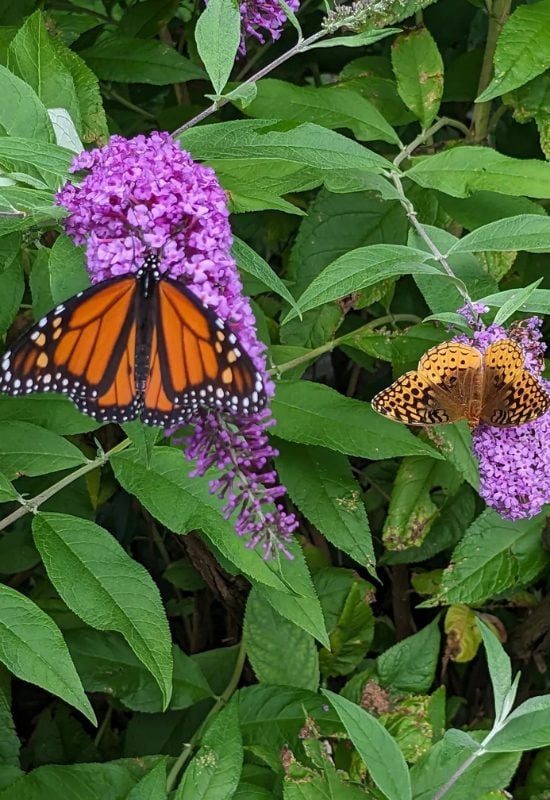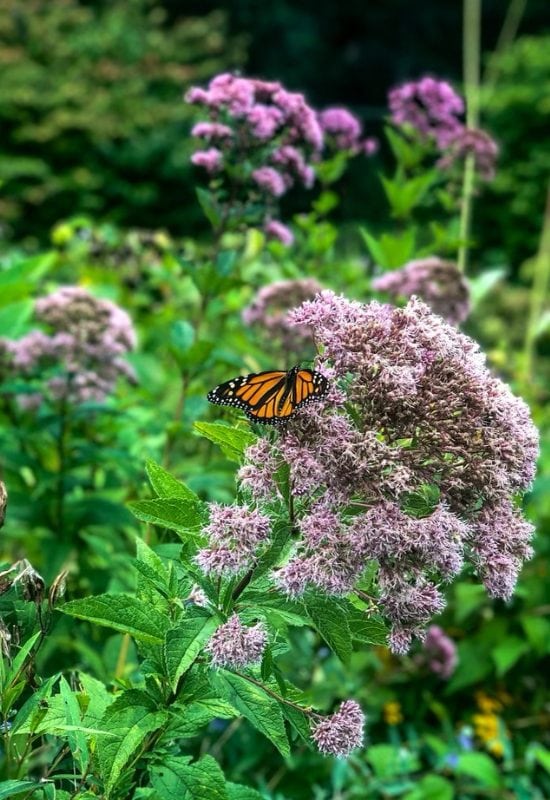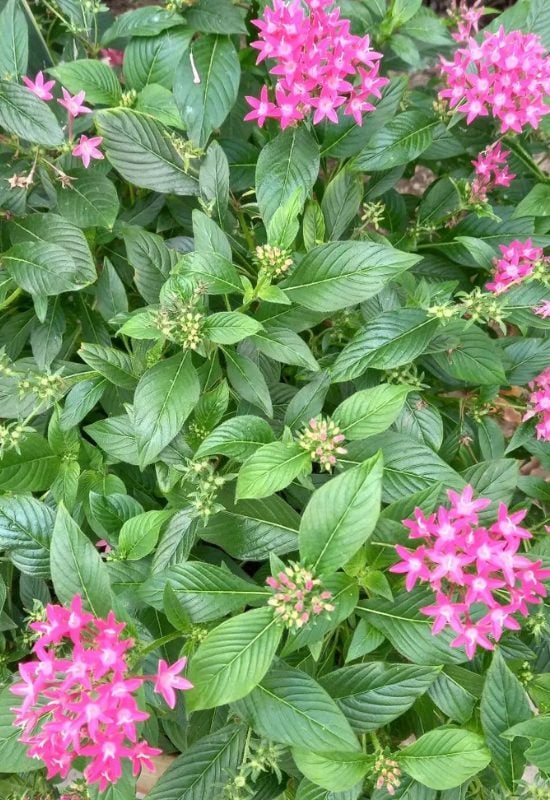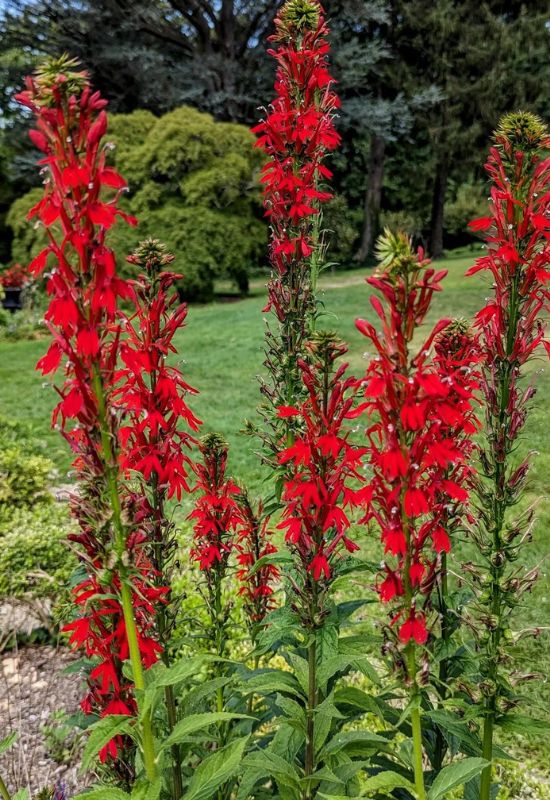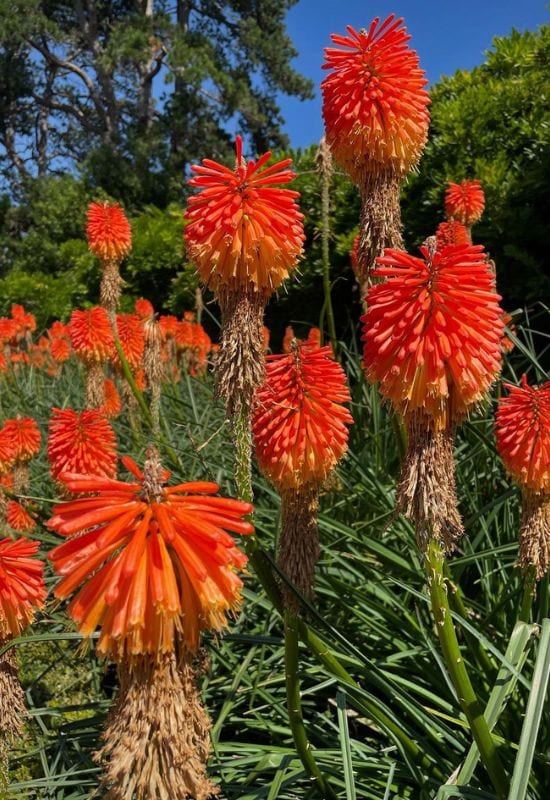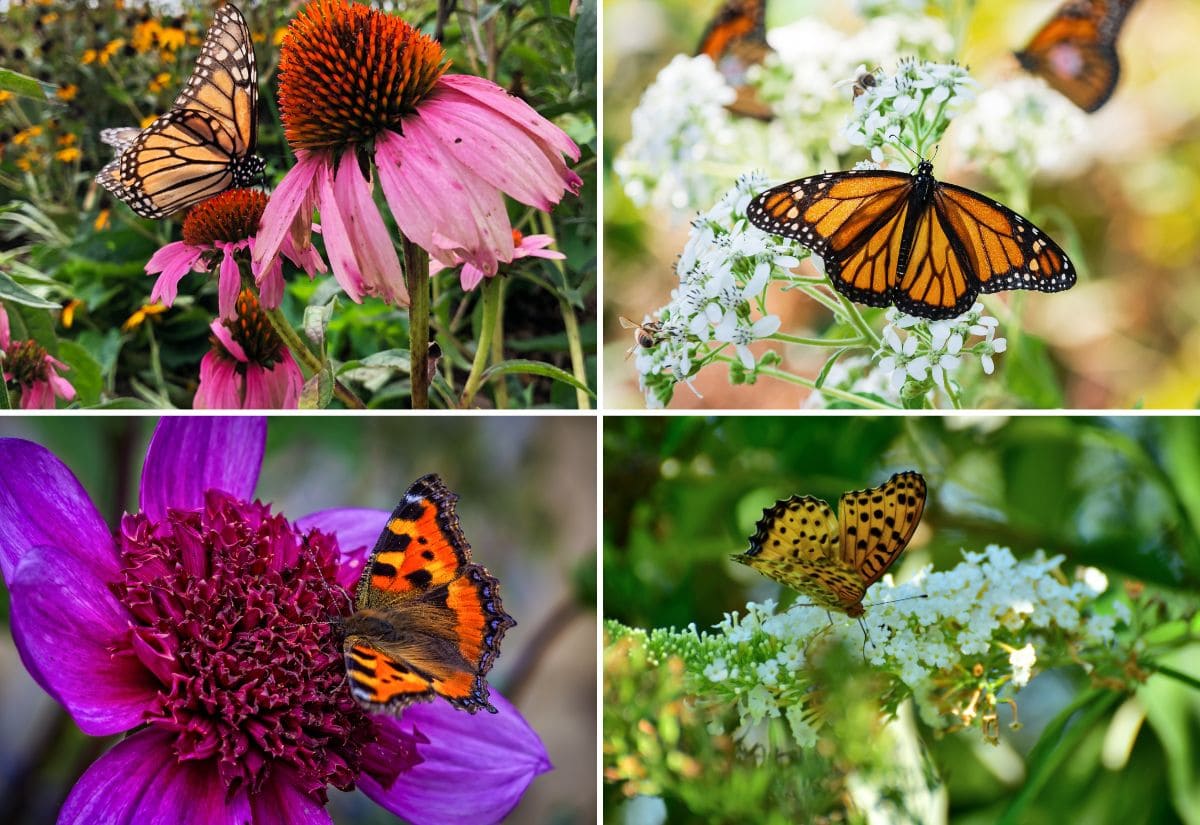
Colorful flowers are always the protagonists of gardens, but, when butterflies dance on them, your whole day becomes sunny, cheerful, alight and full of life!
From wild meadows to formal yards, the world’s most loved insects are not just an addition to the beauty to your plants…
When their fluttering wings sparkle on your blooms, it is like the whole scene changes, it all comes to life. But there is more; feeding on sweet nectar, they also pollinate your blossoms, so they can seed and the whole cycle of Nature and rebirth can start again.
Together with humble birds, buzzing bees, hovering beetles, crawling hedgehogs and little bacteria in the soil, butterflies of all shades and shapes are a sign of a healthy environment, of a thriving habitat for your plants and flowers, as well as colorful harbingers of joy!
Transforming your garden into a full-blown butterfly retreat brimming with monarchs, tiger swallowtails, and other fluttering wonders, is no longer just a dream. The secret lies in selecting nectariferous and melliferous flowers that beckon these winged jewels.
Indeed, by acquainting yourself with butterflies and presenting them with a bouquet of their favored florals, you’ll find these dazzling winged beings becoming frequent guests.
Once planted, your blossoming paradise will become a magnet, welcoming butterflies in day after day.
Whether your garden is already a butterfly’s dream or you’re looking to cultivate such a paradise, here’s a handpicked selection of the 15 most enticing plants and flowers to support and attract butterflies, coupled with insights on garden design and planting, ensuring your blossoms are always accompanied by these fluttering confetti of nature.
Which Flowers Will Attract More Butterflies?
Before we actually look in detail at some outstanding varieties that are real magnets for butterflies, I’d like to go through a few tips and general rules about what these winged dancers really look for in a flower… So you can widen your selection.
Also remember to keep your butterfly flowers in a sheltered position from strong winds; these delicate creatures have delicate wings, designed to flutter in the breeze, not in windy and stormy places!
And now, ready to see which are the very best varieties to attract butterflies to your garden?
29 Flowers That Promise a Spectacular Butterfly Show Right in Your Garden
If you want to make sure that your garden fills with beautiful butterflies, here are 15 flower varieties guaranteed to bring butterflies to your garden.
1: English Lavender (Lavandula angustifolia)
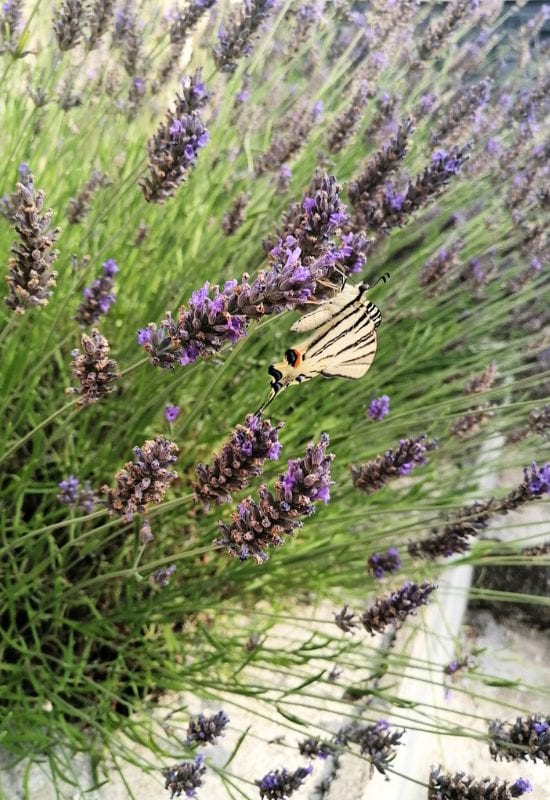
Lavender must be all pollinators’ favorite flower! It may be its enchanting and soothing fragrance, its long lasting and nectar rich blooms, but whenever you see a shrub of this herb, you will always see lots of bees, beetles and butterflies flying over them!
And the English lavender variety is arguably one of the very best to attract butterflies to your yard; it has by far the most perfect (essence like aroma, not soapy, like her French sister, Lavandula stoechas).
What is more, it is a very tough little bush, and the blossoms are massive; they will literally cover the whole plant for two months in summer and sometimes again in fall.
In lilac, white, pink, or bluish or violet, they come at the end of the stems in dense and heavenly smelling clusters. The evergreen foliage is thin, almost needle like and very finely texture, in shades of green, bluish green or even with silver overtones.
English lavender is ideal for borders, but also in large beds or rock gardens; a must in herb yards, it is also the ideal shrub for butterfly gardens – actually the one you cannot do without!
2: Butterfly Bush (Buddleja spp.)
It’s all in the name: of course, butterfly bush attracts lots of… butterflies! There are about 140 species of this genus of shrubs, but the most common are Buddlejadavidii, Buddleja alternifolia and Buddleja x weieriana.
Some are even trees, while the smaller ones, like the ‘Petite’ cultivar series, only reach 3 feet in height (90 cm), which is good news if you have a small garden and you want fluttering wings… All produce long panicles packed with nectar rich flowers, and these can be violet, blue, purple, white, or in some cases even yellow.
Their fragrance is an added bonus, and the long lasting blossoms will feed pollinators into the late months of the season, even till frost!
With a compact habit, the lance shaped green foliage with gray greenish leaves will give structure and depth to borders, and some varieties are even evergreen!
Easy to grow and demanding very little care, butterfly bush is perfect for herbaceous borders and hedges, and very suitable for informal landscaping, containers, foundation planting and even in naturalized areas. And it is a must have in butterfly gardens.
3: Phlox (Phlox spp.)
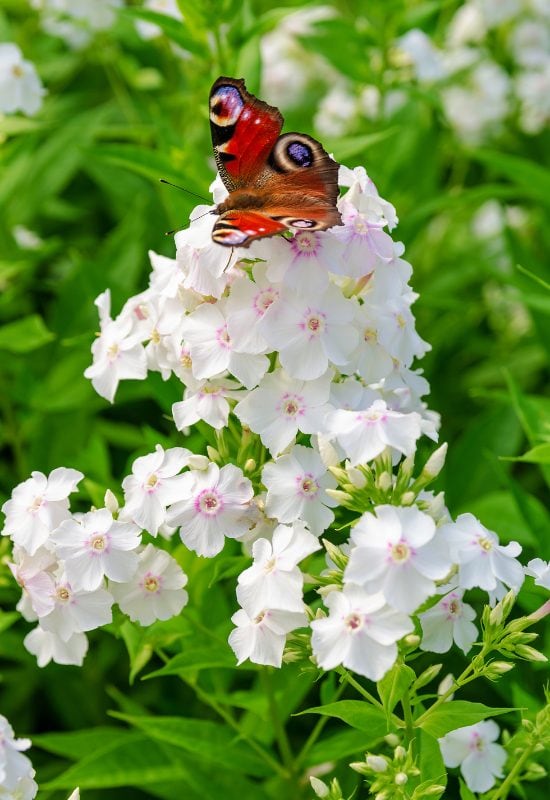
Phlox has an enchanting fragrance, reminiscent of carnations and pinks, and it looks like this is a magnet for butterflies, bees and other pollinators. With both perennial varieties, blooming in summer, and annual ones (like Phlox drummondii), which start earlier in spring, this genus of short flowering plants can keep your delicate winged visitors coming throughout the season.
The clusters of small but graceful flowers can be of many colors: white, pink, mauve, violet, blue, coral and magenta. And there is even a choice for wild, naturalized and shady areas, the start shaped blue winner of the Award of Garden Merit by the Royal Horticultural woodland phlox (Phlox divaricata). The stems also offer you green pointed leaves to form lovely clumps, in some cases, semi evergreen.
Ideal for group planting in garden beds, or even in borders, and a real must in cottage gardens, all phlox varieties require low maintenance but offer you bright colors, long lasting blooms, a heavenly smell, and butterflies dancing on their floral displays.
4: American Elder (Sanbucus canadensis)
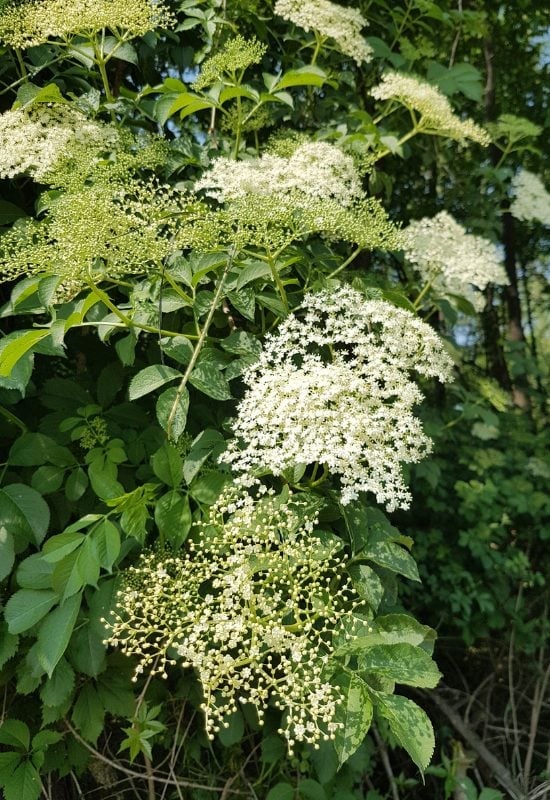
Have you ever walked past an American elder shrub without seeing butterflies all over it? Surely not! This fast growing bush is indeed a favorite and safe refuge for our colorful winged insects, which love its nectar during its bloom time, in summer.
The large flat clusters of small white flowers attract them with their lemon scent, and they also enchant us when we get close to them.
Do look at the closely, because they are actually very pretty, with five very harmonic petals and pistils like rays between them, with pale cram yellow anthers.
And this is how your garden fluttering visitors see them. Followed by its famous, edible berries of a shiny black color, also used for wine and spirits, this bush will decorate your green space well into the fall. And the lush, herbaceous looking foliage, healthy and dense, is another shelter and corridor for little fauna.
America elder is ideal for naturalized areas, river banks and informal gardens to fill borders and hedges or windscreens, not just with foliage, blooms and berries, but with butterflies too: and very fast!
5: Sage (Salvia spp.)
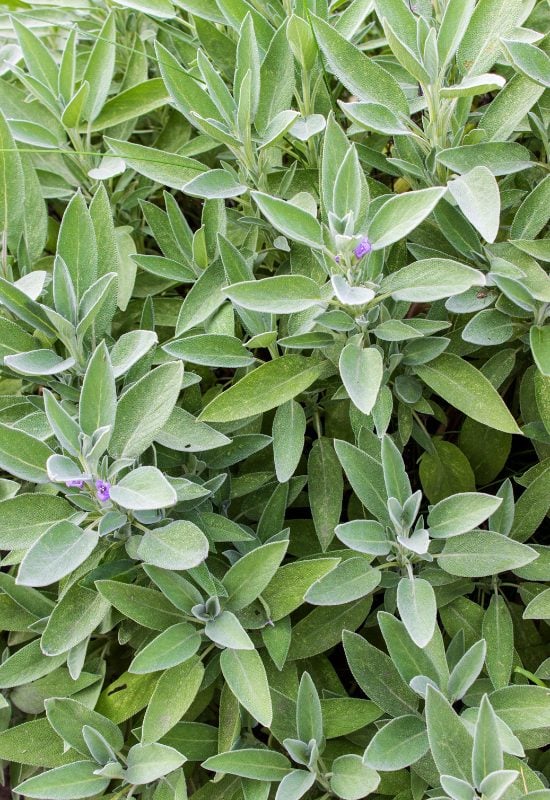
We love sage for cooking, but there are many varieties of Salvia, or sage, even for decorative purposes, not just the herb (Salvia officinalis) – and butterflies love them all! The flowers are small but plentiful, arranged in dense whorls around the stems, and they look like little hoods.
While the main range of shades is blue to violet, and in some cases very intense (like with ‘Indigo Girls’ if you want a vibrant color), there are also red ones, like ‘Hot Lips’ or bicolor (‘Little Kiss’ with white and carmine), ivory on purplish stems (‘Phyllis Fancy’ and the super purple with elongated blossoms ‘Love and Wishes’.
For a delicate rose, instead, I would suggest the Salvia coccinea ‘Coral Nymph’ or ‘Summer Jewel Pink’, with long floral displays all through summer and into fall!
The foliage too chan change a lot, from smooth and green, to fuzzy and silver, like in Salvia argentea and Salvia alpina. And the choice of leaf variegation comes with ‘Tricolor’ (white, green and purple) or ‘Icterina’ (cream and white).
Sage varieties have many uses, from medicinal, to spiritual (Salvia divinorum – illegal in most countries, though) to medicinal and of course, decorative. But, whichever you choose, you can be sure that butterflies will definitely add to its beauty with their heavenly presence.
6: Yarrow (Achillea spp.)
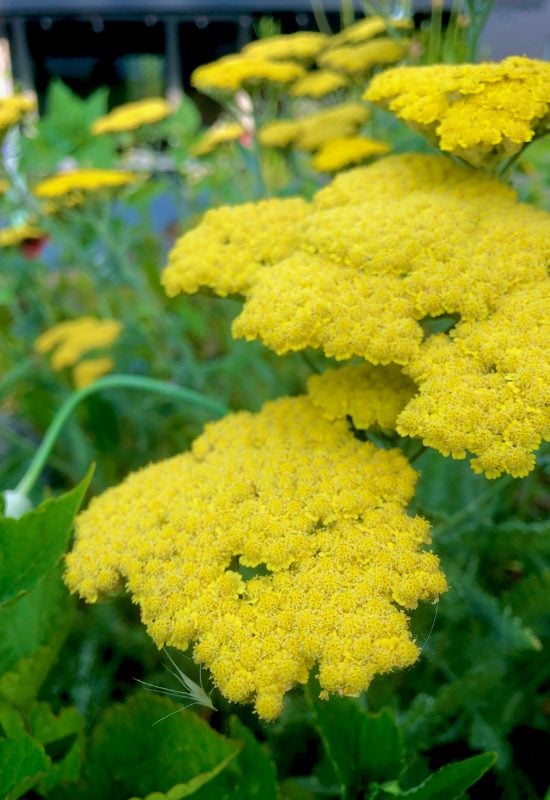
Yarrow is another flowering plant you will never see without lots of pollinators, butterflies, bees and it is a favorite of beetles too. And it is also another sturdy and easy to grow perennial with lots of varieties in different shades… And how could our little winged friends resist those heliports, or landing sites filled with nectar rich blooms?
The inflorescences, (corymbs, technically) are in fact flat and perfect to rest on when feeding… And they can be quite large, especially when clustered all together as they do and in lots of colors…
You can have white, yellow, red, pink, bright magenta and even rare tonalities like coral, peach and brick! Lasting all through the hot months of summer, they come atop incredibly finely textured, fern like, often aromatic and semi evergreen foliage as well!
For a butterfly garden, yarrow is a definite must! But it is also a perfect choice for cottage styled green spaces, herbaceous borders and even wild prairies and meadow, and it is a real friend of healthy lands and habitats.
7: Joe-Pye Weed (Eupatorium maculatum)
Like all the other species of Eupatorium, Joe-Pye weed is a great attraction for butterflies and other pollinators, but it is arguably the most popular garden variety.
Maybe this is because it is easy to grow, or maybe because it has very large and dense clusters of flowers rich in nectar, that brighten up your garden all through the late season!
And it is also loved by experts, as the cultivar ‘Riesenschrim’ has even won the prestigious Award of Garden Merit by the Royal Horticultural Society.
Growing tall in a short time, little insects can see it from a distance, as can visitors to your land and passers by… In shades from rose to purplish, with a strong lavender palette, it will bring its showy floral displays above your head, while the large, serrated and pointed elliptical leaves will be at eye level, disposed like star rays around the stems.
Joe-Pye is a great border or hedge bushy perennial, it can be a good accent or foundation plant, and it will get butterflies hovering above your head with their delicate but colorful wings. It is also a variety that grows well in hard conditions, like coastal areas and wet soil!
8: Egyptian Star Flower (Pentas lanceolata)
For butterflies in a garden in warm and sunny climates, Egyptian star flower is a great choice, sometimes also called with its official name, Pentas. Its name suggests the shape of the flowers, but it is actually slightly deceptive, because they are actually like long trumpets, but they open into five pointed stars.
They come in round clusters of about 4 inches in diameter (10 cm) and they are very elegant throughout the summer months. You can choose between white, red, pink and lilac varieties, and you can grow it as an annual, planting it in spring, if you live in a cold region.
It will grow pretty fast forming a woody perennial subshrub with lovely green and pointed elliptical leaves, with decorative veins on the under page, sheltering little animals that come to your garden as well.
Egyptian start flower will attract butterflies to your beds and borders, best suited for informal styles, but you can also have it in containers. As a cut flower, it is quite good because the stems are straight and the blossoms are long lasting.
9: Lantana (Lantana spp.)
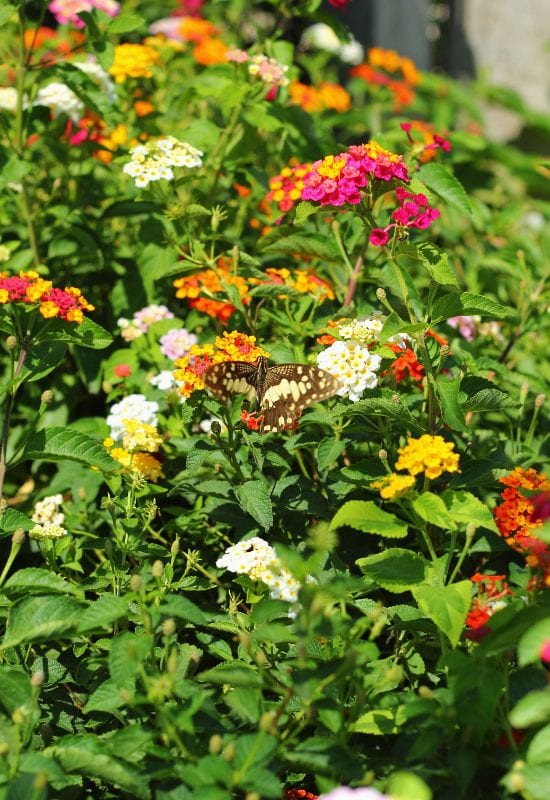
What an extraordinary flowering shrub or perennial is lantana! Its blooms extends all the way from spring to fall, and I have seen it flowering even in winter, in warm countries! This means a steady source of food for many months for butterflies, and this is why they love it.
Or maybe they also appreciate its round, shaped clusters of little flowers with rounded petals. Because they are special: each inflorescence can have blossoms of different colors, white, yellow, pink or red!
And they come in huge numbers in the bushy foliage! You do have varieties with just one shade, but the “Harlequin” ones are an all time favorite. The pointed leaves are serrated, deep green and also deeply grooved, giving you a dense clump of fine texture, and providing corridors for other beneficial visitors to your gardens, like hedgehogs.
Very generous and easy to grow and propagate, strong and beautiful lantana is perfect for borders and hedges in gardens in hot climates, and even difficult growing conditions, like salty soil and dry land. And this makes it very useful for butterflies too!
10: Sunflower (Helianthus annuus)
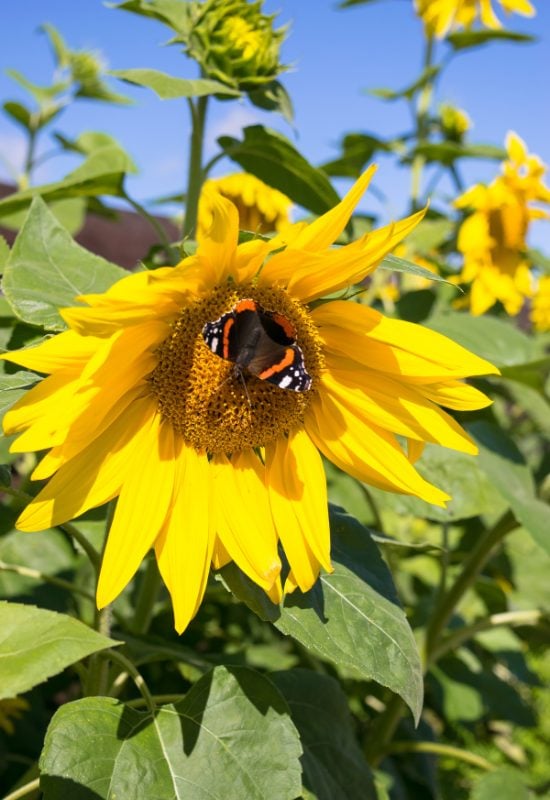
Just imagine how much food butterflies can find on a single sunflower! And in fact, it is not a single bloom, but a large daisy like inflorescence, with many little flowers in the disk as well as in the rays! And because they can be 14 inches across (35 cm) or even more, there’s plenty for all pollinators, and later birds when the nutritious seeds come.
In the colors of summer, yellow, red and orange, they blossom in this season, but there are also varieties with white and pink. This annual grows very fast, and, famously, very tall indeed.
The stems are very thick and tough, of course, as they need to support a lot of weight, and this is not the little insects’! But if you have a small garden, you can always choose a dwarf variety: it will still look huge to your winged visitors! The broad leaves that you see on the sides are rough to the touch, but still very decorative.
Ideal for a vertical accent in all informal gardens (even vegetable ones), sunflowers give you an impressive and energetic floral display with little work and no problems at all! A very safe choice for butterflies.
11: Daylily (Hemerocallis spp.)
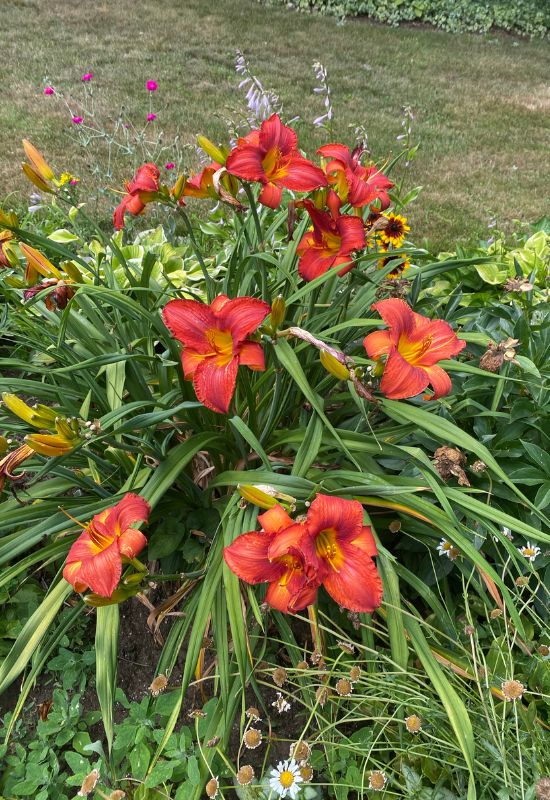
It’s no wonder daylily is one of the most popular flowering perennials, and not just with gardeners, but with butterflies as well! Its big blooms only last one day, but each plant produces loads and for a long time, from mid to late summer.
And they are super easy to grow, spreading spontaneously. About 5 inches wide (12.5 cm), the blossoms are impossible to miss, with their lily shape and super bright colors. Yellow, orange, pink, purple and red in all shades are available, and single heads are far preferred by pollinators.
Even if they come individually, they are rich in nectar and they certainly signal the “landing place” from a big distance! The very lush and fleshy green foliage is dense, with long, strap like and arching leaves, yet another shelter for all forms of little fauna.
Daylily is a perfect border plant; but you can also grow it as ground cover and even in containers, in case you want to attract butterflies and you don’t have a full garden but just a terrace. And there are dwarf varieties as well!
12: Cardinal Flower (Lobelia cardinalis)
Winner of the Award of Garden Merit by the Royal Horticultural Society, cardinal flower is a Lobelia variety with long stems that fill with red blooms till late in the season. These give it its name (though the color is more like an Archbishop’s robe, fiery crimson) and they also send out clear signals to butterflies…
They will come to visit it and feed on it all through its flowering season, and they will look very gracious on the blossoms with three larger lower petals and a hooked upper one… In fact, they do have a similarity with the wings of our colorful insects, and this makes it a perfect choice for a sense of harmony and natural beauty.
Some varieties can have large flower heads, up to 2 inches across (5.0 cm), and the foliage is always rich green, with some leaves on the stem and a rosette at the base. Quite elegant indeed!
You can attract butterflies growing cardinal flower with little maintenance in beds, containers or borders, and it is also ideal for wild prairies and meadows, as well as for cottage gardens, even in very cold countries like the Northern States and Canada! What’s more it also grows in boggy and poorly drained soils!
13: Red Hot Poker (Kniphofia spp.)
You will never be able to reach the nectar in the flowers of red hot poker, a.k.a. torch lily, but butterflies will! And in fact they will come in great numbers, because this decorative perennial from Africa keeps it safe for them.
In fact, the many tubular flowers that literally pack the upright stems keep their sweet treasure at the very end, which makes it difficult for other pollinators to get. But our lepidoptera have a secret weapon, their long proboscis (tongue) can extend and get to it, as do the long bills of hummingbirds!
With bright colors, red, yellow, pink or white, they form lava lamp shaped clusters, and they will also bring lots of vibrant energy to your garden for a very long season, from late spring to fall! Add the beautiful blade like rosettes of evergreen leaves you find at the base of the plant, and you will fully appreciate the decorative value of this amazing plant!
Despite its exotic look, torch lily, or red hot poker, is a cold hardy plant and an easy to grow one. And it can bring butterflies to your flower beds and borders while also giving you a warm and bright vertical accent, like flames burning in your garden.
14: Coneflower (Echinacea spp.)
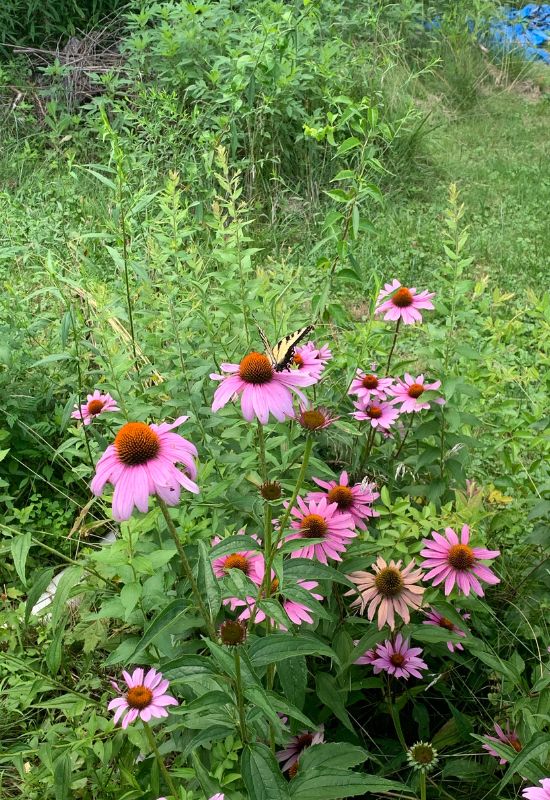
Who knows if butterflies are aware that coneflowers have great medicinal qualities and they help the immune system? For sure they know that they are very rich in nectar and not just healthy for humans but also for them!
Like all daisy like flowers, what appears to us as a rough central disk is in reality a full collection of little flowers, each with something sweet to offer to insects. The “domes” in the middle of the bloom are quite decorative in themselves, but then there are the “petals” which, again, are other blossoms with a big petal, the “rays” as we call them.
And with Echinacea they come in shades of yellow, orange, magenta and even white! And if you want a psychedelic variety, ‘Sweet Sandia’ is deep pink purplish in the center and turquoise greenish at the edges! Its rough, large and pointed leaves form sculptural rosettes at the feet of this long lasting floral display.
Coneflowers are quite popular also because they are tough perennials and easy to grow butterfly friendly flowering plants. For beds, borders, wild meadows and all informal settings, daisy like blooms like those of Echinacea are hard to beat.
15: African Lily (Agapanthus spp.)
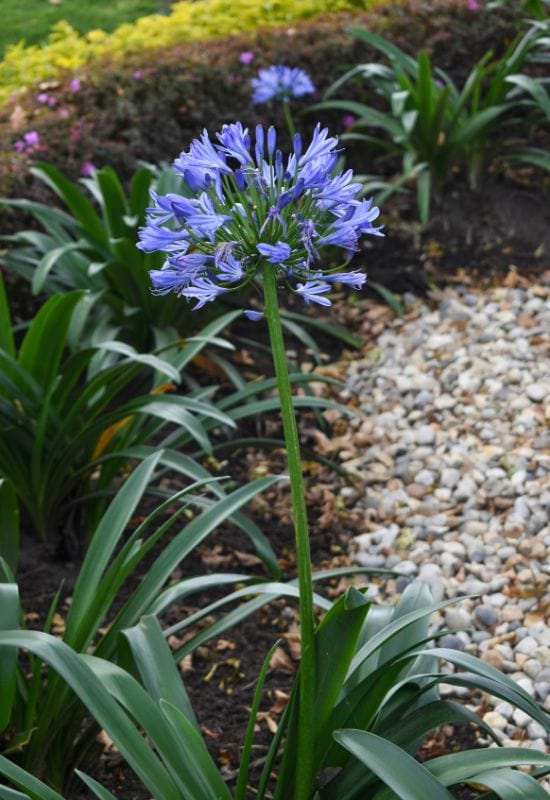
And finally, a start from the rain forests of the Cape Peninsula: African lily, or Agapanthus! It is obvious that butterflies cannot resist the appeal of the big colorful clusters of blooms of this amazing perennial flowers!
They are packed with flowers that appear to us like stars, but, once again, they are actually trumpet or funnel shaped and they keep their nectar safe at the bottom, where few pollinators, like butterflies with their long proboscis, can easily reach. And… Watching them fly around the inflorescences is like seeing them dance around a glitter ball!
This disco impression is due to the perfectly spherical umbels, up to 8 inches across (20 cm)! With vibrant colors or pastel shades in white, blue, amethyst and violet, they are striking protagonists in gardens. The leathery long leaves at the base of the upright stems form lovely tufts of freshness and floridity!
Easy to grow and propagate by clump division, rhizomatous African lily is a real magnet for pollinators but also for visitors to your garden, who will admire both plant and fluttering insects in your beds, borders or even containers! It is ideal for Mediterranean and coastal gardens as well.
Butterflies and Flowers: A Match Made in Heaven!
A butterfly garden has the extra factor! It means life, it means movement, it means sheer joy! And now you can pick some of the amazing varieties you have seen, or follow our guidelines to have a green space or balcony with lots of colorful fluttering wings!
And I have a final tip for you: if you have lots of land and little time, but you love butterflies, sow wild meadow seeds and they will come in great numbers!

Written By
Amber Noyes
Amber Noyes was born and raised in a suburban California town, San Mateo. She holds a master’s degree in horticulture from the University of California as well as a BS in Biology from the University of San Francisco. With experience working on an organic farm, water conservation research, farmers’ markets, and plant nursery, she understands what makes plants thrive and how we can better understand the connection between microclimate and plant health. When she’s not on the land, Amber loves informing people of new ideas/things related to gardening, especially organic gardening, houseplants, and growing plants in a small space.

